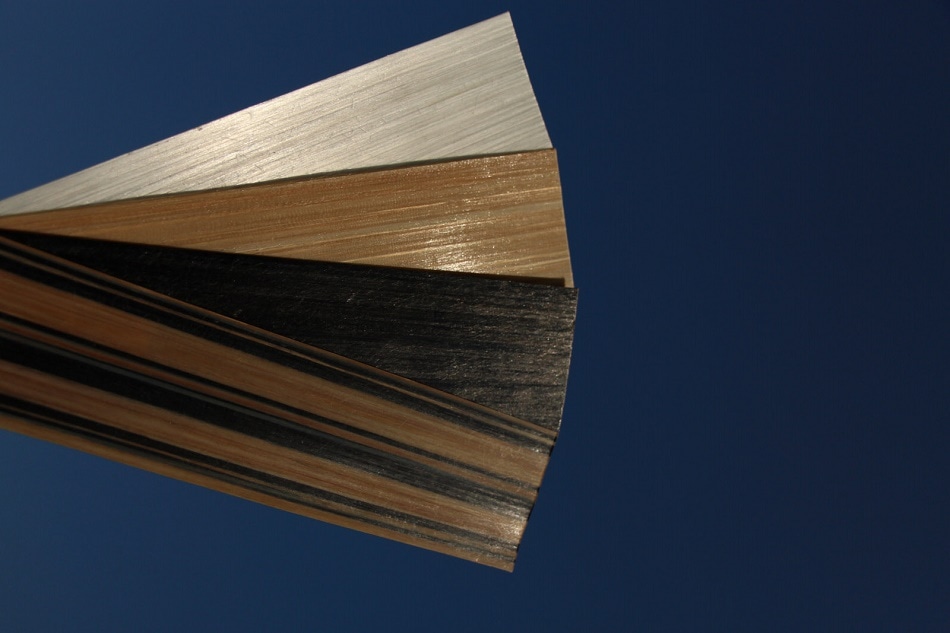Oct 5 2016
 Thermoplastic tapes with different fiber matrix combinations. (Credit: © Photo Fraunhofer ICT)
Thermoplastic tapes with different fiber matrix combinations. (Credit: © Photo Fraunhofer ICT)
As the sizes of offshore wind turbines increase, operators are finding it challenging to transport, install, disassemble, and dispose the gigantic rotor blades of these turbines. In partnership with other industry experts, Fraunhofer researchers are working towards developing highly durable thermoplastic composites and foams that will help in building lighter and recyclable blades.
The special properties of the new materials also help to construct other lightweight structures in domains like the automotive sector. The introductory demonstrators will be kept for display at the K 2016 trade fair in Düsseldorf from 19th – 26th October, 2016.
The trend towards large offshore wind farms is relentless. Wind turbines with rotor blades that measure up to 80 m in length and a rotor diameter of more than 160 m are designed so that maximum energy yields can be attained. As the length of the blades is restricted based on their weight, it is essential for lightweight systems that also possess high material strength to be developed.
If wind turbines are lower in weight they will have enhanced stability at sea, and would be easily assembled and disassembled.
As part of EU’s Wind Blade Using Cost-Effective Advanced Lightweight Design (WALiD) project, scientists at the Fraunhofer Institute for Chemical Technology ICT in Pfinztal are working together with almost 10 industry and research partners to come up with a lightweight design of rotor blades. These scientists intend to reduce the weight of the blades and also to increase its service life by improving the design and the materials used.
Thermoplastics are Replacing Thermoset-Based Materials
Wind turbines are often made by hand thermosetting resin systems. However, these do not allow melting, and are not suitable for material recycling. The best property of granulated thermoset plastic waste is that, they can be recycled and used as fillers in simple applications.
In the WALiD project, we’re pursuing a completely new blade design. We’re switching the material class and using thermoplastics in rotor blades for the first time. These are meltable plastics that we can process efficiently in automated production facilities.
Florian Rapp, Project Coordinator, Fraunhofer ICT
Scientists aim to separate the glass and carbon fibers and reuse the thermoplastic matrix material.
The project partners used sandwich materials that are made up of fiber-reinforced plastics and thermoplastic foams to build the outer shell of the rotor blade and also for the segments of the inner supporting structure. Generally, carbon-fiber-reinforced thermoplastics are used in places where very high loads are applied in the rotor blade, and glass fibers are used to reinforce the less stressed areas.
Rapp and his team of scientists are now developing thermoplastic foams that are bonded with cover layers made of fiber-reinforced thermoplastics in sandwich design for the sandwich core. This combination enhances the durability, efficiency, mechanical strength and longevity of the rotor blade. “We’re breaking new ground with our thermoplastic foams,” says Rapp.
Lightweight Construction Material for New Applications
Compared to existing material systems, the new ICT foams provide better properties. This paves way for new applications in various domains such as aviation, automotive, and shipping industries. Manufacturers have been using foam materials for seating and visors, but not for load-bearing structures.
The current foams have a few limitations, one such limitation is temperature stability. These foams cannot be installed as insulation near the engine.
Our meltable plastic foams, by contrast, are temperature stable and therefore suitable as insulation material in areas close to the engine. They can permanently withstand higher temperatures than, for example, expanded polystyrene foam (EPS) or expanded polypropylene (EPP). Their enhanced mechanical properties also make them conceivable for use in door modules or as stiffening elements in the sandwich composite.
Florian Rapp, Project Coordinator, Fraunhofer ICT
These foams can be processed in a rapid manner and save material. Another advantage of thermoplastic foams is that, they are easily available over other renewable sandwich core materials such as balsa wood. The manufacturing process of these innovative materials takes place in the institute’s own foam extrusion plant in Pfinztal.
We melt the plastic granules, mix a blowing agent into the polymer melt and foam the material. The foamed, stabilized particles and semi-finished products can then be shaped and cut as desired.
Florian Rapp, Project Coordinator, Fraunhofer ICT
In the domain of foamed polymers, the new ICT foam technologies scientist group covers the total thermoplastic foams production chain, ranging from material production and manufacture of extrusion-foamed particles and semi-finished products to finished components and process media.
A miniature wind turbine built using new foams and composites will be presented by the researchers at the K 2016 trade fair in Düsseldor happening from 19th – 26th October, 2016. The demonstrator will be available for public view at the joint Fraunhofer booth, SC01, in Hall 7.0.
The EU’s WALiD project partners include Fraunhofer Institute for Chemical Technology ICT in Pfinztal, Smithers Rapra in Shawbury, WPS Windrad Power Systems GmbH in Bad Doberan, Loiretech in Malville, PPG Industries Fiber Glass in Westerbroek, Norner Research AS in Stathelle, and Coriolis Composites in Quéven. Some of the other project members are NEN in Delft, TNO in Den Haag and COMFIL in Gjern. Approximately €4m has been granted for this project, and this project is expected to happen until 31st January, 2017. The European Community‘s 7th Framework Programme under Grant Agreement no. 309985 has funded this project.